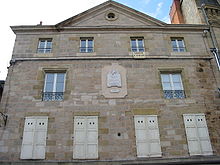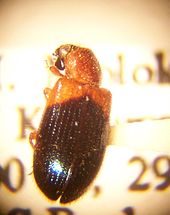- Pierre André Latreille
-
Pierre André Latreille 
Pierre André LatreilleBorn November 20, 1762
Brive-la-Gaillarde, CorrèzeDied February 6, 1833
ParisNationality French Fields entomology, arachnology, carcinology Institutions Muséum National d'Histoire Naturelle Alma mater University of Paris Author abbreviation (zoology) Latreille Pierre André Latreille (November 20, 1762 – February 6, 1833) was a French zoologist, specialising in arthropods. Having trained as a Roman Catholic priest before the French Revolution, Latreille was imprisoned, and only regained his freedom after recognising a rare species he found in the prison, Necrobia ruficollis. He published his first important work in 1796 (Précis des caractères génériques des insectes), and was eventually employed by the Muséum National d'Histoire Naturelle. His foresighted work on arthropod systematics and taxonomy gained him respect and accolades. He was considered the foremost entomologist of his time, and was described by one of his pupils as "the prince of entomologists".
Contents
Biography
Early life
Pierre André Latreille was born on November 29, 1762 in the town of Brive, then in the province of Limousin, as the illegitimate child of Jean Joseph Sahuguet d'Amarzit, général baron d'Espagnac, and an unknown mother; the surname "Latreille" was formally granted to him in 1813, and derives from a nickname of unclear provenance.[1]
He studied to become a priest, initially in Brive, and later in Paris.[1] He entered the Grand Séminaire of Limoges in 1780, and left as a deacon in 1786. Despite being qualified to preach, Latreille later wrote that he had never carried out his functions as a minister, although for a few years he signed the letters he wrote "l'Abbé Latreille" ("the Reverend Latreille") or "Latreille, Prêtre" ("Latreille, Priest").[1]
Even during his studies, Latreille had taken on an interest in natural history, visiting the Jardin du Roi planted by Georges-Louis Leclerc, Comte de Buffon, and catching insects around Paris. He received lessons on botany from René Just Haüy, which allowed him to meet Jean-Baptiste Lamarck.[1]
Necrobia ruficollis
After the fall of the Ancien Régime and the start of the French Revolution, the Civil Constitution of the Clergy was declared in 1790, which required priests to swear an oath of allegiance to the state. Latreille failed to do so and was therefore imprisoned in November 1793 under threat of execution.[1]
When the prison's doctor inspected the prisoners, he was surprised to find Latreille scrutinising a beetle on the dungeon floor.[2] When Latreille explained that it was a rare insect, the physician was impressed, and sent the insect to a 15-year old local naturalist, Jean Baptiste Bory de Saint-Vincent. Bory de St.-Vincent knew Latreille's work, and managed to obtain the release of Latreille and one of his cell-mates.[2] All the other inmates were dead within one month.[2] The beetle had been described by Johan Christian Fabricius in 1775,[3] but recognising it had saved Latreille's life.
Thereafter, Latreille lived as a teacher and corresponded with various entomologists, including Fabricius. In 1796, and with Fabricius' encouragement, Latreille published his Précis des caractères génériques des insectes at his own expense. He was briefly placed under house arrest in 1797, and his books were confiscated, but the influence of Georges Cuvier, Bernard Germain de Lacépède and Jean-Baptiste Lamarck (who all held chairs of zoology at the recently instituted Muséum national d'Histoire naturelle) succeeded in freeing Latreille.[1] In 1798, Latreille was appointed to the museum, where he worked alongside Lamarck, curating the arthropod collections, and published a number of zoological works.[1]
First Empire
Following the death of Guillaume-Antoine Olivier in 1814, Latreille succeeded him as titular member of the Académie des sciences de l'Institut de France.[1] In the following few years, Latreille was especially productive, producing important papers for the Mémoires du Muséum, all of the volume on arthropods for George Cuvier's Le règne animal ("The animal kingdom"), and hundreds of entries in the Nouveau Dictionnaire d'Histoire Naturelle on entomological subjects.[1] As Lamarck became blind, Latreille took on an increasing proportion of his teaching and research work. In 1821, Latreille was made a knight of the Légion d'honneur.[1]
Later years
From 1824, Latreille's health deteriorated. He handed his lectures over to Jean Victoire Audouin and took on several assistants for his research work, including Amédée Louis Michel Lepeletier, Jean Guillaume Audinet-Serville and Félix Édouard Guérin-Méneville.[1] He was instrumental in the founding of the Société entomologique de France, and served as its honorary president.[1]
Latreille's wife became ill in 1830 and died in May of that year; the date of Latreille's marriage is unclear, and his request to be released from his vow of celibacy was never acknowledged.[1] He resigned his position at the museum on April 10, 1832, in order to move to the country and thereby avoid the cholera epidemic. He returned to Paris in November, and died of bladder disease on February 6, 1833.[1] He had no children but was survived by a niece whom he had adopted.[2]
Commemoration
The Société entomologique raised the money to pay for a monument to Latreille. This was erected over Latreille's grave at Père Lachaise Cemetery, and comprised a 9-foot (2.7 m) obelisk with various inscriptions, including one to the beetle which had saved Latreille's life: "Necrobia ruficollis Latreillii salvator" ("Necrobia ruficollis, Latreille's saviour").[2]
As testimony to the high esteem in which Latreille was held, many books were dedicated to him, and up to 163 species were named in his honour between 1798 and 1850.[1] Taxa commemorating Latreille include:[4]
- Lumbrineris latreilli Audouin & H. Milne-Edwards, 1833
- Cecrops latreillii Leach, 1816
- Apseudes latreillii (H. Milne-Edwards, 1828)
- Orbinia latreillii (Audouin & H. Milne-Edwards, 1833)
- Latreillia Roux, 1830
- Cilicaea latreillei Leach, 1818
- Bittium latreillii (Payraudeau, 1826)
- Macrophthalmus latreillei (Desmarest, 1822)
- Eurypodius latreillei Guérin, 1828
Work
 Latreille named the rough woodlouse Porcellio scaber in 1804, and also established the genus Porcellio (1804), the sub-order Oniscidea (1802), the order Isopoda (1817) and the class Malacostraca (1802).
Latreille named the rough woodlouse Porcellio scaber in 1804, and also established the genus Porcellio (1804), the sub-order Oniscidea (1802), the order Isopoda (1817) and the class Malacostraca (1802).
Latreille produced a significant body of scientific work, extending across several fields. He was described by Johan Christian Fabricius as entomologorum nostri aevi princeps ("the foremost entomologist of our time"), and by Jean Victoire Audouin as Entomologiae Princeps ("the prince of entomology").[1]
Taxonomy and systematics
Latreille was significant as the first person to attempt a natural classification of the arthropods.[5] His "eclectic method" of systematics incorporated evidence from all available characters without assuming a pre-defined goal; Latreille repeatedly dismissed anthropocentrism and teleology.[1]
As well as many species and countless genera, the names of many higher taxa are also attributable to Latreille,[1] including Thysanura, Siphonaptera, Pycnogonida, Ostracoda, Stomatopoda, Decapoda, Amphipoda, Isopoda, Xiphosura and Myriapoda.
Typification
Although Latreille named many species, his primary interest was in describing genera.[1] He introduced the concept of the "type species", a species to which the name of a genus is firmly attached.[1] Similarly, he favoured the method of naming families after one of the constituent genera, rather than some defining feature of the group, implicitly designating a type genus for the family.[1]
Selected publiations
- 1796: Précis des caracteres generiques des insectes, disposes dans un ordre naturel. – Paris-Brive, Prevot – F. Boudreaux XII, 3 201 [7].
- 1801 (with Sonnini de Manoncourt) Histoire naturelle des reptiles, avec figures desinées d'apres nature (2 vols., 332 pp.)
- 1802–1805: Histoire naturelle générale et particulière des crustacés et insectes (14 vols.)
- 1806–1809. Genera crustaceorum et insectorum, secundum ordinem naturalem ut familias disposita (4 vols.)
- 1810: Considérations sur l'ordre naturel des animaux composant les classes des crustacés, des arachnides, et des insectes.
- 1822 (with Pierre François Marie Auguste Dejean): Histoire naturelle et iconographie des insectes coléoptères d'Europe Paris: Crevot.
- 1825: Familles naturelles du règne animal, exposés succinctement et dans un ordre analytique/
- 1829: Volume 4. Les crustacés, les arachnides, les insectes: 1–653 In: Georges Cuvier Le règne animal distribue d'apres son organisation, pour servir de base à l'histoire naturelle des animaux et d'introduction a l'anatomie Paris, Deterville.
- 1831: Cours d'entomologie.
- many papers in the Annales du Museum, the Encyclopédie Méthodique, the Dictionnaire classique d'histoire naturelle and elsewhere.
References
- ^ a b c d e f g h i j k l m n o p q r s t u Claude Dupuis (1974). "Pierre André Latreille (1762–1833): the foremost entomologist of his time" (PDF). Annual Review of Entomology 19: 1–14. doi:10.1146/annurev.en.19.010174.000245. http://www.annualreviews.org/doi/pdf/10.1146/annurev.en.19.010174.000245.
- ^ a b c d e David M. Damkaer (2002). "A celebration of Crustacea". The Copepodologist's Cabinet: A Biographical and Bibliographical History, Volume 1. Memoirs of the American Philosophical Society, Volume 240. American Philosophical Society. pp. 114–130. ISBN 9780871692405. http://books.google.co.uk/books?id=TgUNAAAAIAAJ&pg=PA124.
- ^ Lúcia M. Almeida & Kleber M. Mise (2009). "Diagnosis and key of the main families and species of South American Coleoptera of forensic importance". Revista Brasileira de Entomologia 53 (2): 227–244. doi:10.1590/S0085-56262009000200006.
- ^ Hans G. Hansson. "Pierre André Latreille". Biographical Etymology of Marine Organism Names. Göteborgs Universitet. http://www.tmbl.gu.se/libdb/taxon/personetymol/petymol.l.html. Retrieved January 25, 2011.
- ^ David A. Grimaldi & Michael S. Engel (2005). "Diversity and evolution". Evolution of the Insects. Cambridge University Press. pp. 1–41. ISBN 978-0-512-82149-0. http://books.google.co.uk/books?id=Ql6Jl6wKb88C&pg=PA21.
External links
Categories:- Zoologists with author abbreviations
- 1762 births
- 1833 deaths
- People from Brive-la-Gaillarde
- University of Paris alumni
- French entomologists
- Hymenopterists
- Arachnologists
- Carcinologists
- Chevaliers of the Légion d'honneur
- Members of the French Academy of Sciences
- Members of the Royal Swedish Academy of Sciences
- Roman Catholic cleric–scientists
Wikimedia Foundation. 2010.


